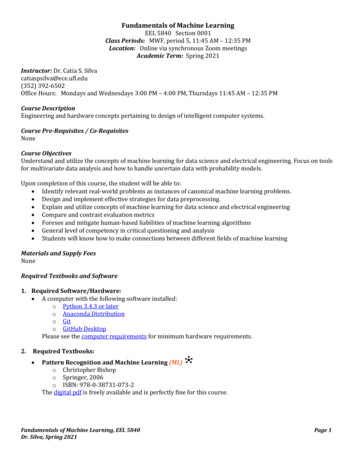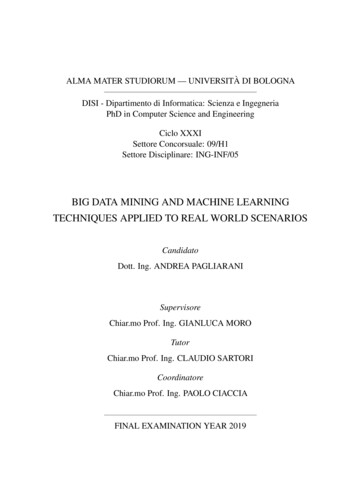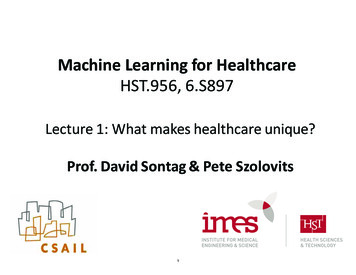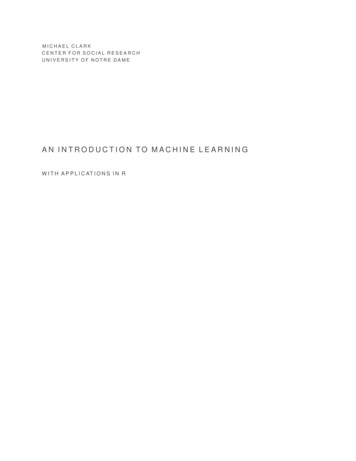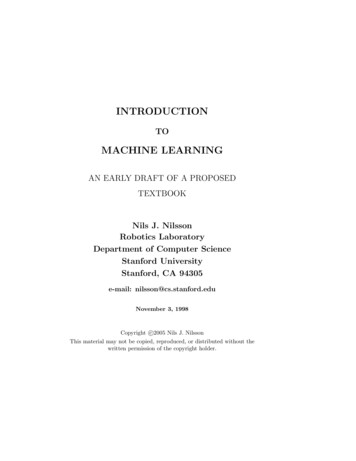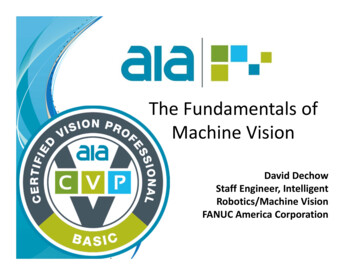
Transcription
The Fundamentals ofMachine VisionDavid DechowStaff Engineer, IntelligentRobotics/Machine VisionFANUC America Corporation
The Fundamentals of Machine VisionINTRODUCTION AND OVERVIEW– What is Machine Vision– The Machine Vision Market– Industrial Uses of Machine Vision
Introduction and Overview What is Machine Vision– Machine vision is the substitution of the human visual sense andjudgment capabilities with a video camera and computer toperform an inspection task. It is the automatic acquisition andanalysis of images to obtain desired data for controlling orevaluating a specific part or activity.– Key Points: Automated/Non‐Contact Acquisition Analysis Data
Introduction and Overview What is Machine VisionImageAcquisition Sensors Optics LightingImageAcquisitionIntegration andApplicationsAnalysis Components Software AlgorithmsAnalysisIntegrationandApplications Results Communications Automation
Introduction and Overview The Machine Vision Market– Choices Well over 400 manufacturers and suppliers Diverse product offerings– Confusion Product/component differentiation sometimes is unclear End‐users (the buyers) often don’t understand what they aregetting– What’s important Components and techniques need to be better understood atthe end‐user level Advanced technology skills are necessary for competentspecification and integration
Introduction and Overview The Machine Vision Market– General Purpose Machine Vision ntrolSignalFrame Grabberor other signalconversionDigitalImage– PC‐based system– Single or multiple cameras interfaced to a computer, standard (Windows, Linux)operating system– Diverse imaging devices available analog (RS170), and digital (GigE Vision, FireWire, Camera Link, USB) interfaces
Introduction and Overview The Machine Vision Market– General Purpose Machine Vision Systems, ControlSignalFrame Grabberor other signalconversionDigitalImageVision System Package“All in One” System“Smart Camera”“Vision Sensor”– Camera sensor and proprietary computer in one package, proprietaryoperating system, ethernet communications– Application configuration external to the deviceOptional ext.computer foroperator interface
Introduction and Overview The Machine Vision Market– General Purpose Machine Vision Systems, ControlSignalFrame Grabberor other signalconversionDigitalImageVision System Package“Hybrid Smart Camera”– Camera sensor or multiple tethered cameras with full computer (keyboard,mouse, monitor, USB, Ethernet), standard (Windows, Linux) or proprietaryoperating system,
Introduction and Overview The Machine Vision Market– System feature overview PC‐based systems– Most flexible and powerful system design– Degree of difficulty varies by implementation– Pricing varies depending upon architecture Smart Camera/Smart Sensor vision system– Includes the easiest to use systems» Some are more difficult to use– Greater danger of over‐specifying capability– Pricing varies widely – can be quite inexpensive Hybrid Smart Camera vision system– Includes some of the features of both depending upon product– Some architectures may pose integration challenges
Introduction and Overview The Machine Vision Market– Camera/processor hardware is just an “image delivery system”!! Differentiation of products at the hardware level is limited to:– Physical structure and system architecture» Single or multiple views? Smart camera – distributed system PC‐based – centralized system» Custom or fixed interface options– Available camera resolutions– Processing speeds– Input/output options– Other hardware integration issues
Introduction and Overview The Machine Vision Market– Peripheral components Lighting Optics I/O devices Frame Grabbers
Introduction and Overview The Machine Vision Market– Application Specific MachineVision Solutions (ASMV) Stand‐alone devicesdesigned for targetedinspection tasks– Imaging, lighting,optics, automation Benefit is a generallyuncomplicated and easyto use inspection devicefor a focused applicationarea
Introduction and Overview The Machine Vision Market– Targeted application components Bar‐ and 2D‐ code readers Other “smart sensors”Product images copyright Cognex,Siemens
Introduction and Overview Industrial Uses of Machine ductorPharma/MedicalDeviceUsers of Machine Vision byIndustry
Introduction and Overview Industrial users of machine vision– Agriculture, Automotive, Biometrics/Security, Container,Cosmetic, Electronics/Electrical, Entertainment, FabricatedMetal, Fastener, Food/Beverage, Glass, Lab Automation,Lumber/Wood, Medical Devices, Medical Imaging,Military/Aerospace, Miscellaneous Mfg., Nanotechnology, Paper,Pharmaceutical, Plastics, Primary Metal, Printing, Rubber,Scientific Imaging, Semiconductor, Telecommunications,Textile/Apparel, Tobacco, Transportation
Introduction and Overview Industrial Uses of Machine Vision– Machine vision application categories Defect detection Gauging Guidance and part tracking Identification OCR/OCV Packaging inspection Pattern Recognition Product Inspection Surface Inspection Web Inspection
AcquisitionIntegrationThe Fundamentals of Machine VisionIMAGE ACQUISITION– Sensors & Imaging– Optics– LightingAnalysis
Image Acquisition Nothing happens in a machine vision application without thesuccessful capture of a very high quality image– Image quality: correct resolution for the target application withbest possible feature contrast Resolution – determined by sensor size and quality of optics Feature contrast – determined by correct lighting techniqueand quality of optics– Imaging is said to contribute more than 85% to the success ofany machine vision application– The goal of machine vision image acquisition is to create animage that is usable by the technology – not necessarily onethat’s pleasing to the human eye
Image Acquisition Sensors and Imaging– All machine vision camerascreate an image by exposingarrays of photosensitivematerial to light energy Think of photon “buckets” Exposure duration is time‐limited and typicallyadjustable The energy in a “bucket”captured during anexposure period becomes amicro‐voltage for that“bucket”
Image Acquisition Sensors and Imaging– Each element in a camerasensor array is called apixel (picture element)– The energy value for eachindividual pixel is outputas a micro‐voltage uponacquisition of each image– the voltage ultimatelydetermines the color levelfor that pixel– The pixel and datatransfer architecturevaries by sensor type most widely used areCCD and CMOS
Image Acquisition Sensors and Imaging– The imaging sensor array comes in different physical layouts Area Line– Size of the chip varies widely as does the number of individualpicture elements (pixels) Typical area chip for machine vision: from .3 to 5 Mpix– 640 to 2048 pixels (horizontal)– Physical sizes from ¼” diag. up to 1” Typical line scan array: from 1K to 12K pixels– Physical sizes from about 15mm to 90mm
Image Acquisition Sensors and Imaging– Image representation in the 5255255255
Image Acquisition Sensors and Imaging
Image Acquisition Sensors and Imaging– What about color? Bayer filter Three‐chip
Image Acquisition Sensors and Imaging– Image resolution Key element in vision component selection The smallest feature resolved by the imager Determinants: What is the size of the field of view (FOV),and what is the required accuracy of the imaging. How many pixels? InspectionDefect detection(for example onlyactual requirement Feature locationvaries by application) Feature differentiationGaugingPixels required (usually)Min. 2x2Min. 3x3Min. 5x5Sub‐pixel resolution must be1/10th the desired tolerance
Image Acquisition Sensors and Imaging– Image Resolution ExamplesWe need to detect a 0.1” (diam.) defect (high contrast) on a surface that is 3’ square.Given good lighting and high‐quality optics, what camera resolution do we need?The defect diameter should span about 2 pixels so a pixel must cover 0.05”. Over 36”therefore, there must be 720 pixels (36 / 0.05). We must select a camera with at leastthat resolution in the minor axis (vertical) – probably one with a 1024x780 sensor.We must differentiate an emblem that is approximately 1” high relative to a verysimilar feature in a low‐contrast image. If we use a standard resolution camera (640 x480), how large should the field of view be?At minimum, a differentiable object must cover 5 pixels. Due to the low contrast, wedecide to double that coverage to 10 pixels. The target pixel size will be 0.1” (1” / 10),and the field of view must be no larger than 48” (480 x .01).
Image Acquisition Optics– Application of optical components Machine vision requires fundamental understanding of thephysics of lens design and performance Goal: specify the correct lens– Create a desired field of view (FOV)– Achieve a specific or acceptable working distance (WD)– Project the image on a selected sensor based on sensorsize – primary magnification (PMAG)– Create the highest level of contrast between features ofinterest and the surrounding background; with thegreatest possible imaging accuracy
Image Acquisition Optics– Considerations for lens selection Magnification, focal length, depth of focus (DOF), f‐number, resolution, diffraction limits,aberrations ( roll‐off, chromatic, spherical, field curvature, distortion), parallax, image size, etc.– Some geometric aberration may be corrected in calibration The physics of optical design is well known and can be mathematically modeled and/orempirically tested– Specification or control of most of the lens criteria is out of our handsS5S6Images: Edmund Optics; www.edmundoptics.com
Image Acquisition Optics– Considerations for lens selection Practical specifications for machine vision:PMAG (as dictated by focal length) andWD to achieve a desired FOV– Use a simple lens calculator and/ormanufacturer lens specifications– Simple – state the required FOV, thesensor size based on physicalselection of camera and resolution,and a desired working distance –calculate the lens focal length» Note – specified workingdistance may not be availablefor a given lens – reviewspecifications– Test your results Always use a high‐resolution machinevision lens NOT a security lensImages: PPT Vision;pptvision.com
Image Acquisition Optics– Why use machine vision lenses only Light gathering capabilityand resolutionImages: Edmund Optics; www.edmundoptics.com
Image Acquisition Optics– Specialty Lenses Telecentric Microscope stages Macro, long WD Zoom (caution recommended)Images: Edmund Optics; www.edmundoptics.com ,Navitar; www.navitar.com
Image Acquisition Lighting– Science or art?– Correct lighting must Highlight features to be detected relative to background Create repeatable images regardless of part variation– Incorrect lighting will put se of the visionapplication at risk Machine vision cameras and software algorithms CANNOTmake up for inadequate illumination techniques
Image Acquisition Lighting– Illumination for machine vision mustbe designed for imaging, not humanviewing Selection must be made relativeto light structure, position,Diffusecolor, diffusionReflectionLight SourceSpecular We need to know how lightReflectionworks so our light selections arenot “hit and miss” guesswork Light is both absorbed andreflected to some degree fromRefraction, Absorptionall surfaces– When an object is clear ortranslucent, light is alsotransmittedTransmitted Light (if– Angle of incidence angleobject is notof reflectioncompletely opaque)
Image Acquisition Lighting– Dedicated lighting must be used for machine vision with fewexceptions.– Where feasible, LED illumination is the best source Long life with minimal degradation of intensity Able to be structured into a variety of shapes– May be directional or diffuse May be strobed at very high duty cycles and overdriven to manytimes nominal current specifications Available in many visible and non‐visible colors– Other sources – fluorescent, fiber‐optics Fluorescent – bright and highly diffuse but can be inconsistent Fiber optic – glass/plastic fibers delivering light from halogen,tungsten‐halogen or xenon source, bright, shapeable, focused
Image Acquisition Lighting– Lighting Techniques The goal of lighting for machine vision applications usually isto maximize the contrast (grayscale difference) betweenfeatures of interest and surrounding background Techniques are categorized generally by the direction of theillumination source– Most may be achieved with different sources
Image Acquisition Lighting Techniques– Direct bright‐fieldillumination Sources: high‐anglering lights (shown),spot‐lights, bar‐lights(shown); LEDs orFiber‐optic guides Uses: generalillumination ofrelatively high‐contrast objects; lightreflection to camera ismostly specularImages: CCS America; www.ccsamerica.com
Image Acquisition Lighting Techniques– Diffuse bright‐fieldillumination Sources: high‐anglediffuse ring lights (shown),diffuse bar‐lights; LEDs orfluorescent Uses: general illuminationof relatively high‐contrastobjects; light reflection tocamera is mostly diffuseImages: CCS America; www.ccsamerica.com
Image Acquisition Lighting Techniques– Direct dark‐field illumination Sources: low‐angle ringlights (shown), spot
Image Acquisition Analysis . – Processing speeds – Input/output options – Other hardware integration issues. Introduction and Overview The Machine Vision Market – Peripheral components Lighting Optics I/O devices Frame Grabbers. Introduction and Overview The Machine Vision Market – Application Specific Machine Vision Solutions (ASMV) Stand‐alone .

